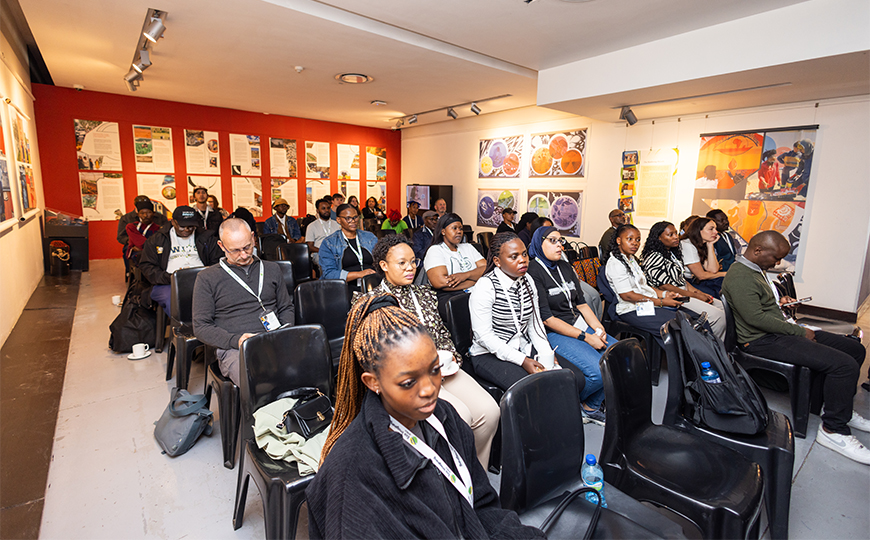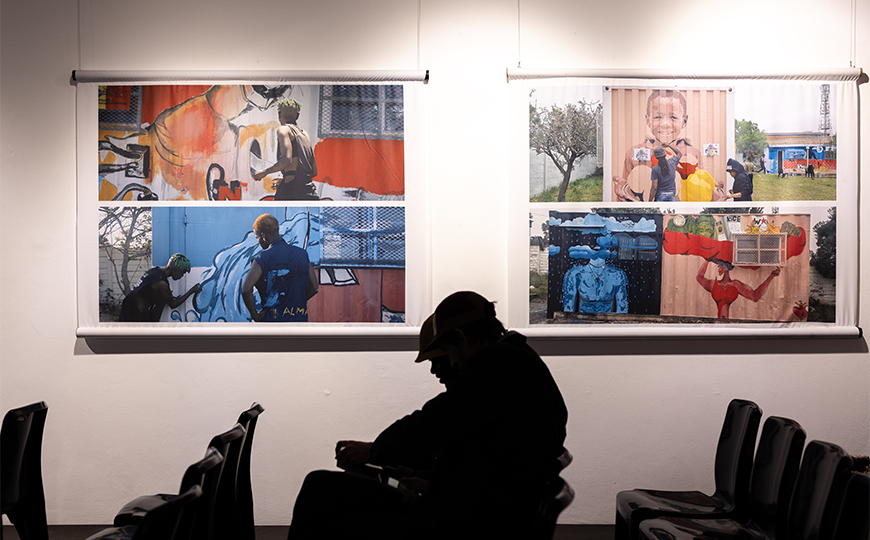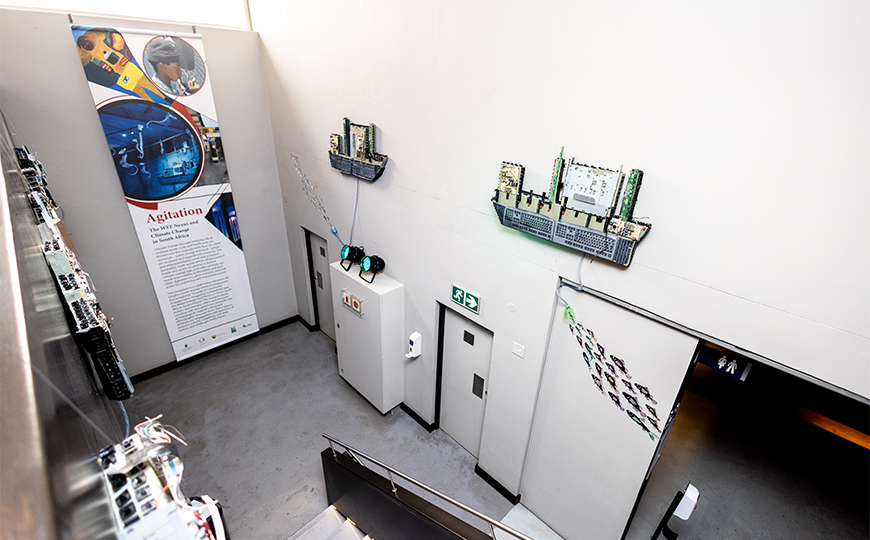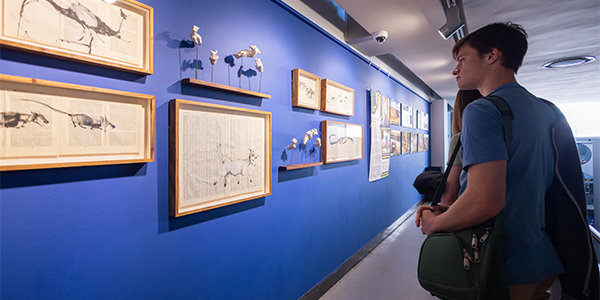Agitating for understanding
- Wits University
Arts and science interrogate water, energy, and food precarity at conference-exhibition.
‘The sky was mourning.’ ‘Life stops without electricity.’ ‘One must hustle for a plate of food.’ These were some of the statements on the stairway up to Agitation: The WEF Nexus and Climate Change in South Africa, a conference and exhibition that took place at and in collaboration with the Origins Centre at Wits University from 1-3 October 2025.
The 20 statements on the stairs are verbatim comments taken from interviews that postgraduate and postdoctoral researchers conducted. These literal statements are the words of the people with whom the researchers work. They are the words of people speaking from their own experiences of the precarities of water, energy, and food.
Eco-Imagining, a research collective, hosted Agitation. Formally known as Ecological Community Engagements: Imagining Sustainability and Water-Energy-Food Nexus, Eco-Imagining studies systems thinking in practice, using methods and techniques of community engagement, citizen science and arts-based methods.

Lenore Manderson, Distinguished Professor of Public Health and Medical Anthropology at Wits and Professor Eileen Moyer, Chair of the Department of Anthropology at the University of Amsterdam, lead Eco-Imagining.
Manderson says, “Agitation has multiple meanings. It includes to disturb or to move or to shake. It's to stir up public interest in a matter of controversy. This conference is a major dissemination and policy conversation of the Eco-Imagining programme. We’re interested in the way in which water, energy, and food – although essential for life – are unequally distributed, and what it means to live precariously among people who are marginalised or excluded from much of the workings in society.” This particular conference-exhibition was located within the context of climate change.
Manderson said delegates should “keep in mind who we are speaking for, or who we are thinking about, when we discuss water, energy and food, and climate change.”
The underlying and overriding argument is that climate change differentially affects people depending on their location within society, she said.
Arts-based methods agitate
The stairway statements were just one of provocative and compelling art installations carefully curated to ‘agitate.’ Another was an ochre-orange-red-brown-blue mural that snakes along the wall on the pathway to the Origins Centre entrance. An image of an actual snake entwines around an image of the Vodacom tower in Hillbrow. Stepping back from the mural, discarded plastic bottles and apples covered with plastic come into view – these are the ways in which big business and corporations impact the environment to the detriment of water, energy, and food.
Shipping container murals

Inside the Origins Centre, images of the Mdantsane Murals Shipping Containers and the Mankweng Murals project were exhibited. Artists Mook Lion and Phila Phaleso led these projects as part of Eco-Imagining in 2024. These projects aimed to nurture the skills of young creatives in these communities by sharing studio space in the shipping containers, which also provided an exterior for the murals. The murals created provided a site specific, grounded, and engaging way to think through – and visually depict – the challenges that face residents in accessing water, energy, and food. Mook Lion and Phila Phaleso attended Agitation, along with several of their crew, and participated in the Art as Intervention roundtable discussion.
Ships making waves
Artist Christine Dixie’s The Abyssal Zone was first exhibited at the University of Fort Hare in February 2025. According to the artist's bio, “Dixie shows astronauts inhabit deep water; colonial and modern-days ships cross the skies, fish sail through celestial scapes. Having jeopardized the future on earth’s surfaces, we now disrupt planetary order. Reproduced via video for Agitation, Dixie’s installation at Origins also included displays of industrial ships made of circuit boards – ships that damage marine life because, ironically, the rare metals required to power batteries that store energy (to mitigate using fossil fuels) require plundering the ocean.

The Litter Traps and Art project
Artist and honorary research fellow at Wits’ Global Change Institute, Hannelie Warrington-Coetzee exhibited both her prints and photographs of sculptures created from waste and debris in Johannesburg’s Jukskei River via the Litter Traps and Art Project.
“The Litter Trapping Art project was really to figure out as artists: how do we get this waste out of the river? From a materials perspective, with it being so full of pollution, we then also started investigating how we can actually clean the river,” explains Warrington-Coetzee. “The second project kicked off a couple of months later, where we could employ a whole team of specialists. That took a good three months of investigation. The report is also at the exhibition.”

Other arts interventions at Agitation included Emily Ragus’ ‘body maps’ of the KZN floods in 2022. The body maps grow from workshops on the use of art to illustrate memory, to understand people’s lived experience of injury and healing.
Postgraduates’ research posters on display aligned with some of the statements on the stairway. For example, one research poster discussed community food gardens (and spinach), a phrase reflected on the stairs.
“The point is that each community may have their own community garden, but you do not change the structures of race, class, gender, and the long arc of the histories of this country by yet another food garden,” Manderson points out.
“Interventions are often tailored to local communities, but they're tailored in ways that means that they're not sustainable, or that no one takes responsibility for maintaining infrastructure. And so, the challenge is: can you have a community-based intervention and what will it do to that community in the longer term? And the reality is that any intervention without major structural change is always a stopgap measure.”
Ecologies of imagination
The conference aspect of Agitation included a panel discussion chaired by Professor Nithanya Chetty, Dean of the Faculty of Science and titled From Knowledge to Action and Justice: What are we doing? Discussants included Coleen Vogel Distinguished Professor of Climatology at Wits’ Global Change Institute; Wits’ Vishwas Satgar; Alexander Kagaha, Makerere University; Jonathan West, Section 27; Mafoko Phomane, groundwork; and Andries Bezuidenhout, University of Fort Hare.
Professor Eileen Moyer, University of Amsterdam delivered the keynote address, titled Ecologies of Imagination: Water, Energy and Food in South Africa’s Transforming Landscapes. Moyer alluded to agitation as “a practice of imagination” as “imagination is the condition of our survival.”
Using three case studies – a plastics-for-food initiative in Golden Valley in Johannesburg’s CBD; emerging green hydrogen corridors in the Northern Cape; and multispecies wine ecologies in the Western Cape – Moyer showed how ecological transition is not only a technical challenge but a deeply social and moral one, shaped by histories of extraction, racialised dispossession and uneven development.
“Plastic bottles are not just pollutants, but social and political actors shaped by the ecologies of imagination through which people struggle to survive,” says Moyer and urged delegates to “spread the seeds of agitation.”

